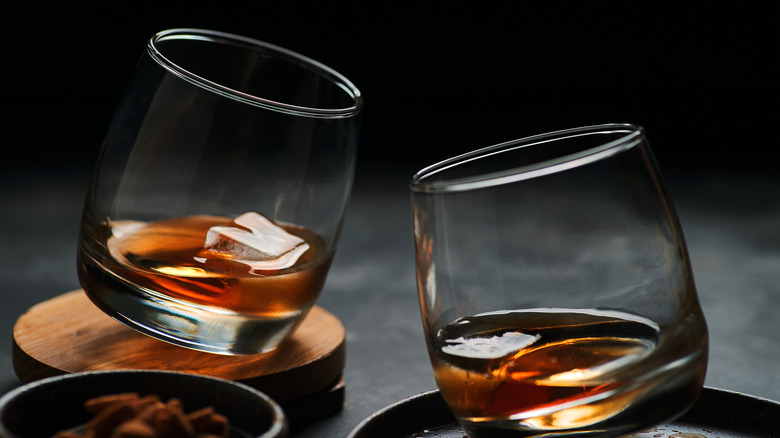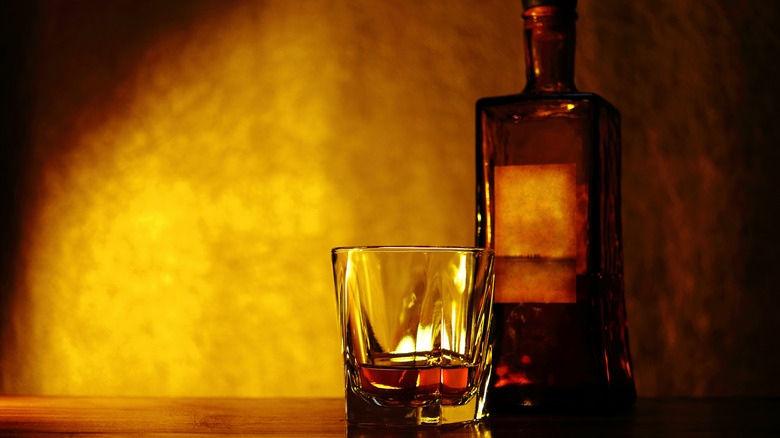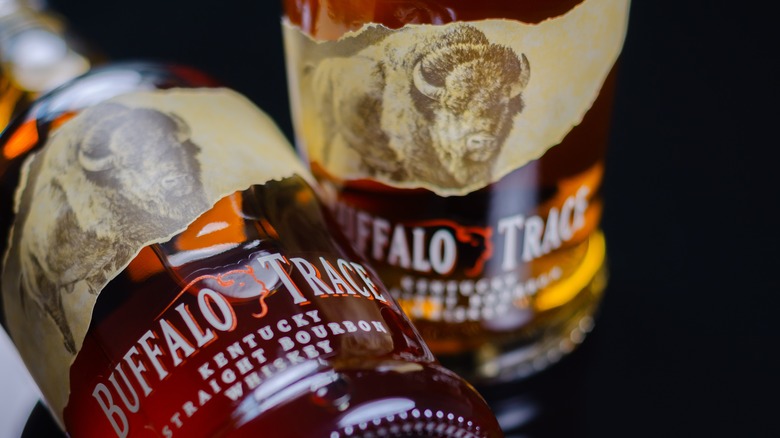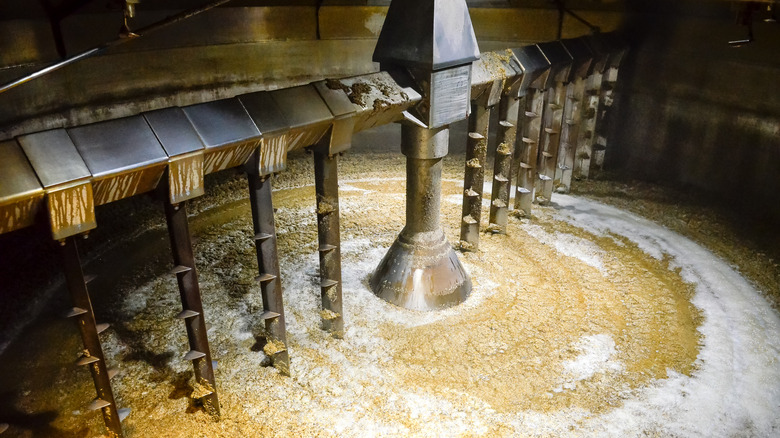The Difference Between High-Rye And High-Corn Bourbon
The bourbon world can be as straightforward or as complex as you make it. For newcomers and weekend warriors, seeing the bourbon title on the bottle is all the information they need. But there are good reasons to dig deeper if you're so inclined; not the least of which is that you can start to pinpoint the exact styles that you enjoy drinking the most.
There are a lot of types of bourbon out there, but high-rye bourbon and high-corn bourbon are two styles to remember since they are more specific to flavor profiles than, say, the single barrel bourbon category. The downside is that the designation of high-rye and high-corn are rarely included on the label, so you may need to do some sleuthing to find out what bourbons are in which club. The situation is further complicated by the fact that not all bourbon distilleries release their mash bills, which is bourbon jargon for the ingredient list. For example, Buffalo Trace uses a lot more corn in its bourbon than you might expect, but its mash bill is a trade secret, so the exact percentage is a mystery.
Despite these obfuscations, high-rye and high-corn are both still well-known categories, and it isn't that difficult to find excellent examples of both on the shelves. Word to the wise: It may be easier to pick the category you want and search for examples rather than identify the bottle and decode which category it's in if you're just starting to explore.
What is high-rye bourbon?
All bourbon must contain at least 51% corn in its mash bill by law (though it's often higher than that), which is typically mixed with malted barley and rye. We'll dive into the typical bourbon mash bill more in a second, but for now, suffice it to say that a high-rye bourbon will increase the percentage of rye in the mash bill. A high-rye bourbon does have an upper limit, though, since corn still has to be the primary ingredient. If the mash bill ever contains 51% rye or more, it's no longer a high-rye bourbon but rather a fully fledged rye whiskey.
Popular examples of high-rye bourbon include Redemption High Rye, Old Grand-Dad, and Bulleit Bourbon. As you can see from these whiskeys, the high-rye aspect is only sometimes highlighted. Both Old Grand-Dad and Bulleit Bourbon self-classify as Kentucky straight bourbon whiskey despite fitting into the high-rye genre. We point this out to highlight the sometimes hidden nature of these designations. As for why these brands choose to keep it off the label, it's likely a marketing decision. If the brands didn't think high-rye was a good style of bourbon, then it wouldn't be made with a high-rye mash bill. But since most consumers don't dive too deep into the weeds on subcategories, simplicity on the label could be a way to garner a broader appeal.
What is high-corn bourbon?
If all bourbon must contain 51% corn in the mash bill, doesn't that mean that all bourbon is high-corn? No, not really. In this case, the corn content is high relative to the typical bourbon's corn content. There are some high-corn bourbons that take the designation so literally that they actually use a mash bill of 100% corn, which obviously sits at the extreme edge of the genre; not all of them go so far.
Almost all high-corn bourbons could be labeled as corn whiskey if the brands wanted, but bourbon is a more popular type of whiskey than corn whiskey, so there isn't much reason to do so. There are also more steps that a distillery needs to take to make bourbon over corn whiskey. If the distillery put in the effort to produce a high-corn bourbon, it's likely going to cash in on that extra effort.
The obvious recommendation for a high-corn bourbon is Buffalo Trace, but George Dickel is good, and Frey Ranch has a 100% Malted Corn Bourbon that is worth a look if you want to try a 100% corn mash bill. There is less of a rallying cry around high-corn bourbons than there is with high-rye bourbons, so expect to be looking for specific mash bills. Once you've started to familiarize yourself with different bourbons' mash bills, you'll likely be able to identify whiskies with higher percentages of corn, but it takes some practice.
High-rye bourbon is spicy, while high-corn bourbon is sweet
Rye is a type of grain that some people may recognize from baked goods like rye bread. Rye is known for its black pepper flavor profile, which means rye gives bourbon a spicy taste. The spiciness of rye mixes with the bite of bourbon's alcohol content in a way that can be off-putting for people who prefer softer, more mellow flavor profiles. That said, the high-rye bourbon industry is garnering a lot of attentionm, and more distilleries are creating entries in the genre to capitalize on the enthusiastic market.
Corn, on the other hand, is sweet — it's what gives bourbon its signature sweetness relative to other whiskies. The more corn there is in the mash bill, the more that flavor profile comes to the fore. Now, this isn't to say that high-corn bourbons taste sugary. But the bite of rye is rounded out, softened, and smoothed over. This softness becomes further exaggerated with wheated bourbons, which replace the rye with wheat — another relatively sweet flavor profile. There are dozens of excellent wheated bourbons out there, but high-corn bourbon still retains a little bit of an edge thanks to its rye content.
As far as flavor profiles go, you can expect high-rye bourbons to carry notes of black pepper, sage, and dill, while high-corn bourbons carry stronger notes of vanilla, caramel, and butterscotch. Specific bottles in each genre will vary somewhat from these broad strokes, of course.
Both bourbon styles deviate from the average mash bill
As we mentioned before, the high-corn and high-rye designations only make sense in relation to something else, since higher is a relative term. Here, both of these terms refer to the average straight bourbon. The difficulty in creating a cut and dry comparison is that there is no one single bourbon mash bill dogmatically celebrated as the true bourbon mash bill. That said, bourbon fans aren't totally in the dark.
A traditional bourbon mash bill will contain roughly 65%-79% corn, 8%-19% rye, and 3%-15% barley. When we are talking about high-rye bourbons, we generally mean any bourbon that has a rye content of 20% or more. High-corn bourbons, by comparison, are any bourbons that contains 80% corn or more. If there is such a thing as a hard red line for any of this, here it is. Keep in mind that the more percentage share one ingredient has, the less room there is in the pie for everything else.




